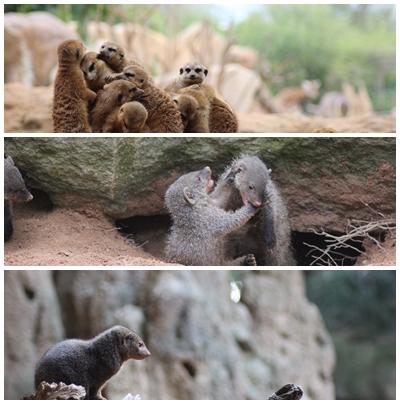Discussion

The present study aimed to investigate the effects of environmental enrichment on the behaviour of meerkats, banded mongooses and dwarf mongooses in captivity (Fig.1). Results showed that both types of enrichments, food and olfactory, did influence the behaviour of these three groups of animals.
The first experiment of the present study demonstrated that presenting a food enrichment to animals in captivity can improve their welfare allowing them to express a larger part of species-specific behaviour repertoire and with a better frequency distribution. Multiples studies (Doolan & Macdonald, 1996; Clutton-Brock et al., 1998; Thornton et al. 2008) pointed out that ‘foraging’ is the most common activity for meerkats in the wild, which shows how important it is to offer them enrichments that can increase the frequency of this behaviour. This ‘foraging tube’ increased by 9.4% ‘foraging’ in this group of meerkats, showing the success of this use of techniques. A fact that was also corroborated by the increase shown in the group of banded mongooses (10.5%) and the group of dwarf mongooses (16%). Meerkats, banded mongooses and dwarf mongooses spent more time interacting with the enrichment when worms were placed inside the tube. This may indicate that these animals can detect the worms by acoustic or olfactory cues as they are not able to see the worms hidden in the hay.
The second experiment showed that there were no significant differences in the way these three groups behaved in the presence of a predator’s odour (hyena) compared to the way they did in the presence of a non-predator’s odour (elephant). The results showed the animals were not very interested in the enrichment, except for the first minutes after the introduction. However, previous studies (Hollén & Manser 2007) measuring their alarm calls have confirmed that meerkats in captivity can differentiate odours (faeces) of potential predators from that of herbivore species. This may indicate that animals can warn their group members based on the species from which the faeces originated but the presence of this sensory enrichment may not have a longer influence on their behaviour once they have inspected it.
Conclusion
It can be concluded from the present study that environmental enrichments do affect the behaviour of the groups of meerkats, banded mongooses and dwarf mongooses living in human care. Out of the types of enrichments tested, the food enrichments were the most successful ones. Using devices, such as the one described in this study, can increase the frequency and duration of foraging up to 16%. For all three species, the amount of time was higher when food was present in the device, which indicates that this kind of enrichment is more successful when there is food involved. On the other hand, based only upon the behaviours recorded and the time spent interacting with the faecal samples, neither of these three groups of mongooses reacted differently to the presence of a hyena (predator) odour or the presence of an elephant (non-predator) odour. Nevertheless, it is important to continue developing methods of enrichment to ensure the good welfare of these animals in captivity.
References:
Clutton-Brock, T. H., Gaynor, D., Kansky, R., MacColl, A. D. C., McIlrath, G., Chadwick, P., ... & Skinner, J. D. (1998). Costs of cooperative behaviour in suricates (Suricata suricatta). Proceedings of the Royal Society of London. Series B: Biological Sciences, 265(1392), 185-190.
Doolan, S. P., & MacDonald, D. W. (1996). Diet and foraging behaviour of group‐living meerkats, Suricata suricatta, in the southern Kalahari. Journal of Zoology, 239(4), 697-716.
Hollén, L. I., & Manser, M. B. (2007). Persistence of alarm‐call behaviour in the absence of predators: a comparison between wild and captive‐born meerkats (Suricata suricatta). Ethology, 113(11), 1038-1047.
Thornton, A. (2008). Early body condition, time budgets and the acquisition of foraging skills in meerkats. Animal Behaviour, 75(3), 951-962.
Responsible for this page:
Director of undergraduate studies Biology
Last updated:
05/10/20
